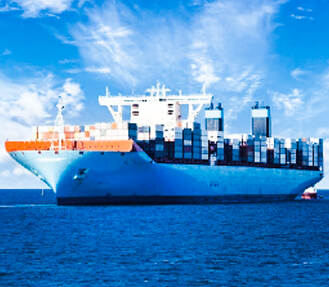Sea Transportation Service to Vietnam: Your Complete Guide to Efficient & Reliable Shipping
In today's global economy, sea transportation remains the backbone of international trade, particularly for emerging markets like Vietnam. As one of Southeast Asia's fastest-growing economies, Vietnam has become a crucial destination for businesses worldwide. Whether you're importing manufacturing components, exporting finished goods, or expanding your market reach, understanding sea freight services to Vietnam is essential for your supply chain success.
This comprehensive guide will help you navigate the complexities of sea transportation to Vietnam, ensuring your goods arrive safely, efficiently, and cost-effectively.
Why Choose Sea Freight for Shipping to Vietnam?
Cost-Effectiveness
Ocean shipping offers the most economical solution for transporting large volumes of goods. Compared to air freight, sea transportation can be 60-80% less expensive, making it ideal for heavy, non-perishable, or large-quantity shipments.
Capacity for Large Volumes
From full container loads (FCL) to less-than-container loads (LCL), sea freight accommodates virtually any shipment size. Modern container ships can carry thousands of containers simultaneously, providing unparalleled capacity for businesses of all scales.
Environmental Considerations
Sea transportation is among the most carbon-efficient methods of cargo movement. According to the International Maritime Organization, shipping produces significantly lower carbon emissions per ton-mile than air transportation, aligning with sustainable business practices.
Key Shipping Routes to Vietnam
Major Port Connections
Vietnam's strategic coastline features several deep-water ports that connect to global shipping lanes:
-
Cat Lai Port (Ho Chi Minh City): Vietnam's busiest container handling facility
-
Hai Phong Port: Gateway to Northern Vietnam and industrial zones
-
Da Nang Port: Central Vietnam's main maritime hub
-
Vung Tau Port: Handling larger vessels and energy shipments
Main Shipping Routes
-
Trans-Pacific routes from North America
-
Asia-Europe services connecting Vietnamese ports to European markets
-
Intra-Asia network linking Vietnam with regional manufacturing hubs
-
Australia-Vietnam direct services
Types of Sea Freight Services Available
Full Container Load (FCL)
Ideal for businesses shipping enough goods to fill an entire container. Benefits include:
-
Exclusive use of container
-
Reduced handling of goods
-
Enhanced security
-
Faster transit times
Less Than Container Load (LCL)
Perfect for smaller shipments that don't require a full container:
-
Cost-sharing with other shippers
-
Flexible volumes
-
Regular departure schedules
-
Professional consolidation services
Specialized Equipment
For unique cargo requirements:
-
Reefer containers for temperature-sensitive goods
-
Open-top containers for oversized items
-
Flat racks for heavy machinery and construction equipment
-
Tank containers for liquid cargo
The Shipping Process: Step by Step
1. Preparation and Documentation
Proper documentation is crucial for smooth customs clearance:
-
Commercial invoice
-
Packing list
-
Bill of lading
-
Certificate of origin
-
Import/export declarations
2. Container Loading and Transportation
-
Professional packing and securing of goods
-
Container sealing and verification
-
Land transportation to port of departure
3. Ocean Transit
-
Regular updates on vessel position
-
Monitoring of weather and routing
-
Compliance with international shipping regulations
4. Arrival and Customs Clearance
-
Advance submission of documents to Vietnamese customs
-
Coordination with local agents
-
Payment of applicable duties and taxes
5. Final Delivery
-
Container unloading and inspection
-
Transportation to final destination
-
Empty container return
Customs Regulations in Vietnam
Essential Requirements
-
Accurate HS code classification
-
Complete and consistent documentation
-
Compliance with import restrictions and prohibitions
-
Proper valuation of goods
Common Challenges and Solutions
-
Language barriers: Work with English-speaking local agents
-
Changing regulations: Partner with updated logistics providers
-
Complex paperwork: Utilize digital documentation systems
-
Customs delays: Submit documents in advance
Choosing the Right Logistics Partner
Key Selection Criteria
-
Experience with Vietnamese market: Local knowledge is invaluable
-
Network strength: Established relationships with carriers and customs officials
-
Tracking capabilities: Real-time visibility throughout the journey
-
Financial stability: Ensure long-term partnership viability
-
Customer service: Responsive communication and problem-solving
Value-Added Services
Look for providers offering:
-
Customs brokerage
-
Cargo insurance
-
Warehousing and distribution
-
Supply chain consulting
-
Risk management solutions
Cost Considerations and Timeframes
Typical Transit Times
-
From West Coast USA: 18-25 days
-
From Europe: 25-35 days
-
Intra-Asia: 5-14 days
-
From Australia: 10-18 days
Factors Affecting Costs
-
Container size and type
-
Fuel surcharges
-
Port fees and terminal handling charges
-
Customs duties and taxes
-
Insurance premiums
-
Seasonal demand fluctuations
Emerging Trends in Vietnam Sea Freight
Digital Transformation
-
Automated documentation processes
-
Real-time container tracking
-
Digital freight marketplaces
-
Blockchain-based supply chain solutions
Infrastructure Development
-
Ongoing port expansion projects
-
Deep-water terminal construction
-
Improved intermodal connections
-
Special economic zone development
Sustainability Initiatives
-
Green port certifications
-
Slow steaming to reduce emissions
-
Alternative fuel exploration
-
Carbon offset programs
Tips for Successful Shipping to Vietnam
Best Practices
-
Plan ahead: Allow extra time for customs clearance
-
Verify documentation: Double-check all paperwork for accuracy
-
Insure your shipment: Protect against potential losses
-
Partner locally: Work with experienced Vietnamese agents
-
Stay informed: Keep abreast of regulatory changes
-
Build relationships: Develop long-term partnerships with providers
Common Pitfalls to Avoid
-
Incomplete or incorrect documentation
-
Underestimating customs clearance time
-
Choosing carriers based solely on price
-
Neglecting cargo insurance
-
Failing to account for seasonal variations



